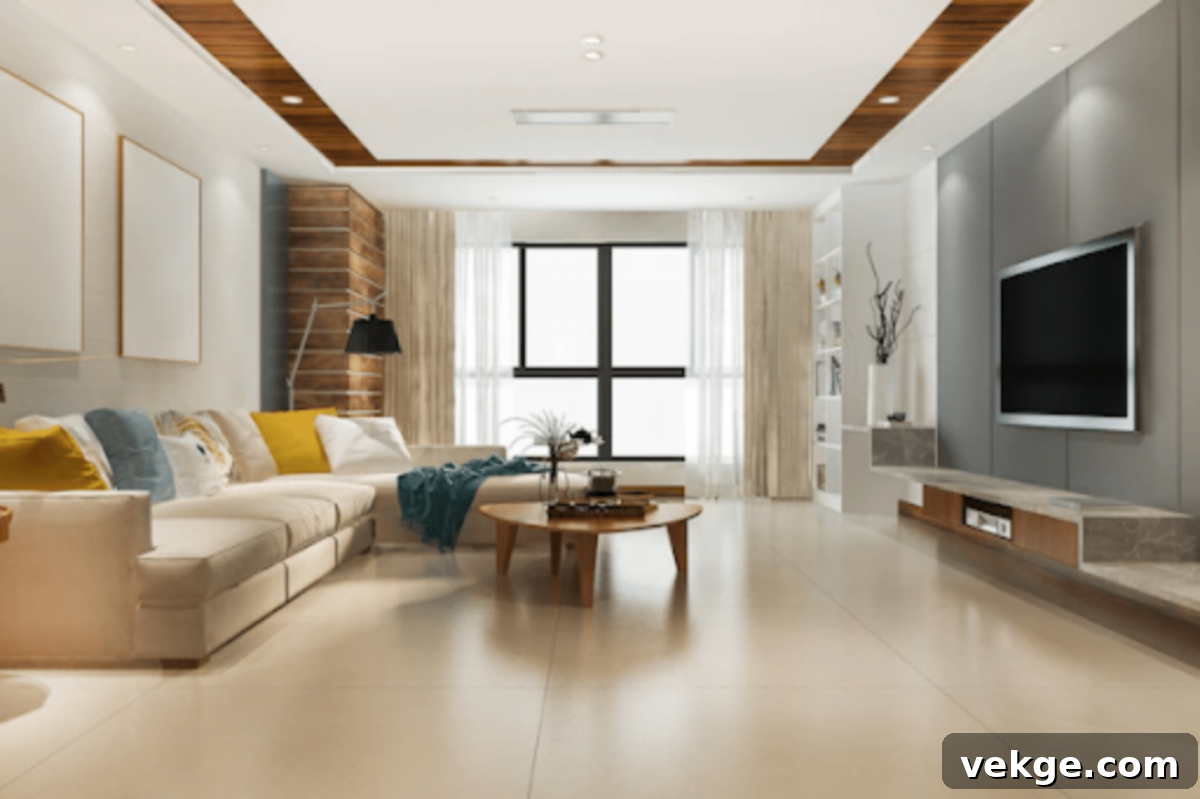Elevate Your Home: Stunning Ceiling Designs and Textures to Transform Your Space
When envisioning a dream home, our focus often gravitates towards architectural styles, paint colors, furniture, and flooring. Yet, there’s one crucial element that frequently goes overlooked: the ceiling. Often referred to as the “fifth wall,” the ceiling plays a pivotal role in defining the character, mood, and overall aesthetics of any room. Far too often, we settle for plain, uninspired ceilings, missing a golden opportunity to add depth, dimension, and a touch of unique personality to our living spaces.
A well-chosen ceiling design can do more than just complete a room; it can transform it entirely. It can influence how light interacts with the space, make a room feel larger or cozier, conceal imperfections, and even contribute to acoustic comfort. Investing thought and effort into your ceiling’s appearance is an act of design magic that can elevate your home from ordinary to extraordinary.
In this comprehensive guide, we’ll delve into some of the most captivating and impactful ceiling designs and textures available today. Whether you’re aiming for a classic, modern, rustic, or luxurious ambiance, there’s a ceiling texture perfectly suited to your vision. Join us as we explore these creative possibilities to help you unlock the full potential of your home’s interior.
The Unseen Potential: Why Ceiling Textures Matter
Before diving into specific designs, let’s understand why paying attention to your ceiling is so vital. Beyond mere decoration, ceiling textures offer a multitude of functional and aesthetic benefits that can significantly enhance your home environment.
- Adds Character and Style: A textured ceiling instantly introduces visual interest and a unique character that flat ceilings simply cannot achieve. It acts as a design statement, reflecting your personal style and enhancing the overall theme of your home.
- Conceals Imperfections: One of the most practical advantages of textured ceilings is their ability to discreetly hide minor imperfections, cracks, or unevenness that might be present in the drywall or plasterwork. This can save time and effort on extensive surface preparation.
- Enhances Depth and Dimension: Textures create shadows and highlights, giving the ceiling a three-dimensional quality that adds depth and makes the room feel more dynamic and engaging.
- Improves Acoustics: Certain textures can help to absorb sound, reducing echoes and creating a quieter, more comfortable environment, especially in larger rooms or open-plan living spaces.
- Reflects Light Uniquely: Depending on the texture and paint finish, a textured ceiling can interact with natural and artificial light in fascinating ways, diffusing it softly or creating dramatic visual effects.
- Defines Spaces: In open-concept homes, different ceiling treatments can subtly define functional zones without the need for physical barriers.
With these benefits in mind, it’s clear that the ceiling is much more than just a structural element; it’s a canvas awaiting your creative touch. Now, let’s explore some of the top choices for ceiling textures that can transform your residential spaces.
Top Choices of Ceiling Textures to Transform Your Home
Many homeowners mistakenly believe that ceiling design options are limited to simple paint or popcorn texture. However, thanks to advancements in materials and techniques, a vast array of types of ceilings and textures are available today, each offering a distinct aesthetic and feel. It’s essential to understand the characteristics of each to select the one that best complements your home’s existing architecture and your personal style. Here’s a detailed look at some popular options:
1. Texturing Sand’s Swirl (Swirl Texture)
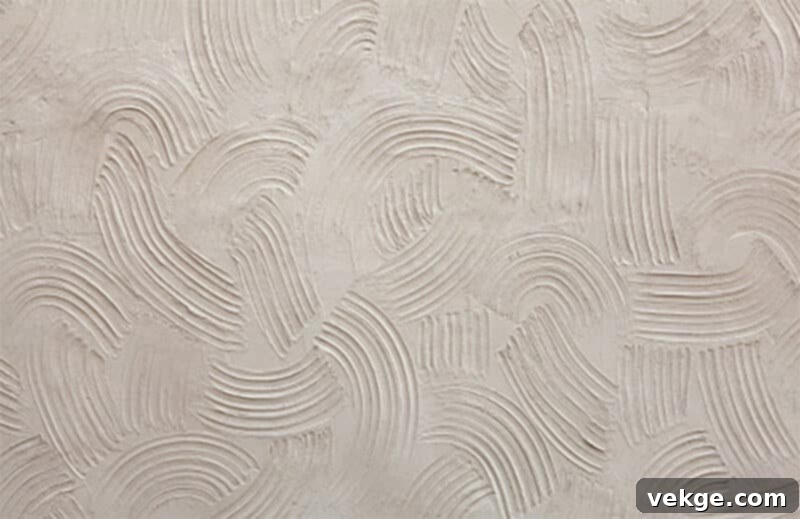
The Sand’s Swirl texture is a captivating design that effortlessly draws the eye and adds a unique, handcrafted feel to any room. This distinctive pattern is characterized by overlapping half or full circles, giving the ceiling a dynamic sense of movement and depth. Its formation typically involves mixing fine sand with a drywall compound, which is then skillfully applied to the ceiling surface.
Artisans and installers use specialized tools such as a bristle brush, sanding sponge, or a small-notched trowel to create the circular patterns while the compound is still wet. The swirling motion results in a textured finish that is both elegant and rustic. This particular design is an excellent choice if you’re aiming to imbue your home with an old-world charm, a Mediterranean vibe, or a cozy, vintage aesthetic.
Beyond its aesthetic appeal, the Sand’s Swirl texture is also remarkably effective at concealing minor surface imperfections, such as small cracks or inconsistencies in the drywall. This makes it a practical solution for older homes or rooms where extensive surface preparation might be costly or time-consuming. The immense degree of depth added by the swirls can make a room feel more intimate and inviting, offering a visually rich alternative to plain ceilings.
2. Floral Pattern for Ceiling
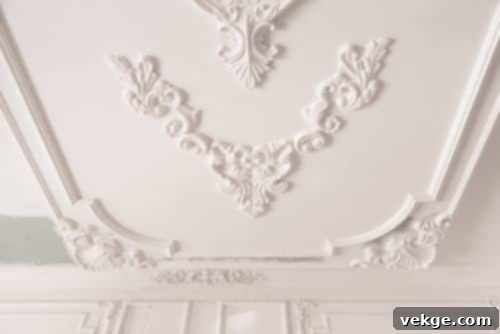
For those seeking to infuse their home with an air of luxury and sophistication, a floral pattern ceiling is an exquisite choice. This design goes beyond simple texture, incorporating intricate botanical motifs that can range from subtle stenciling to elaborate hand-painted murals or embossed panels. The primary consideration with this style is that its successful incorporation often requires a high level of artistic skill and precision to achieve a truly stunning effect.
There are numerous creative approaches to applying floral patterns. You might opt for delicate, repetitive stencils for a consistent look, or commission a unique, hand-painted design that turns your ceiling into a breathtaking piece of art. The final aesthetic largely depends on the chosen method, the complexity of the pattern, and the color palette used. Unlike full-coverage textures, floral designs often don’t cover the entire ceiling; instead, they can be strategically placed to create focal points or used to frame architectural features.
This selective application makes floral patterns an excellent option for covering specific imperfections or drawing attention away from less desirable features. We highly recommend utilizing these elegant designs in areas where luxury and visual impact are desired, such as formal living rooms, elegant dining rooms, and, most notably, in master bedrooms where they can create a serene and opulent retreat. Pairing floral ceilings with complementary wall decor and furnishings can create a cohesive and deeply luxurious interior design.
3. Slap Brush Texture (Stomp Texture)
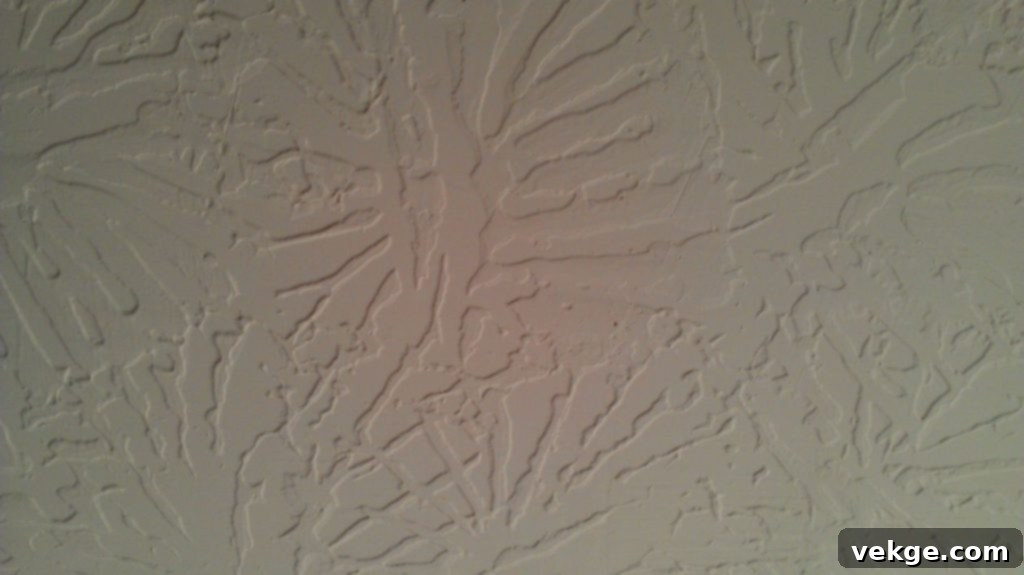
The Slap Brush, or Stomp, texture is an ideal option for those who wish to add a unique, somewhat organic pattern to their ceiling, characterized by a series of thin, interwoven lines and irregularities. This particular texture is incredibly popular among DIY enthusiasts because it’s relatively straightforward to achieve and can result in significant cost savings compared to professional installation.
To create this appealing finish, you’ll first need to prepare a drywall compound by mixing it with water until it reaches a consistency similar to thick paint. This mixture is then gently applied to the ceiling using a roller or a paint sprayer. Once the compound is evenly spread, the magic happens with a specialized “slap brush” or “stomp brush.” This brush, often round with stiff bristles, is lightly pressed or “slapped” onto the wet compound and then pulled away, creating a distinctive pattern of raised lines and peaks.
The beauty of the slap brush technique lies in its inherent randomness, which results in a naturally artistic and informal look. The ultimate finishing helps to dramatically improve the aesthetics of your room by adding an impressive degree of depth and creating a stunning visual interest that catches the light beautifully. It can effectively hide minor surface flaws and adds a rustic or eclectic charm, making it suitable for bedrooms, family rooms, or even more casual living spaces.
4. Comb Style Texture (Trowel Textures)
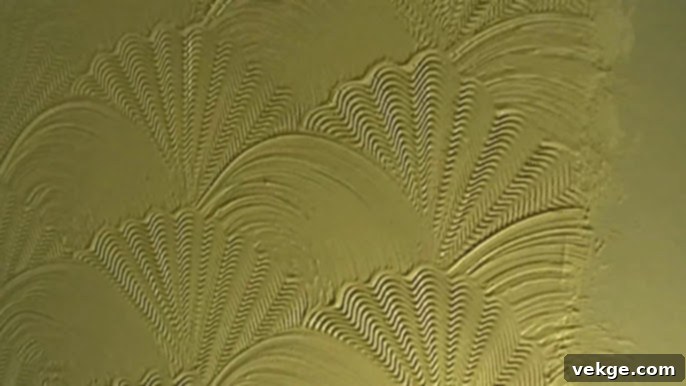
The Comb Style texture offers a relatively simpler yet highly versatile approach to ceiling design. As its name suggests, this texture is created using various types of combs or specialized trowels with notched edges to etch distinct lines and patterns into a wet surface. It is typically applied to a fresh layer of wet plaster or drywall compound, allowing the artisan to manipulate the material before it dries.
While often associated with repetitive patterns like straight lines, waves, or semicircles, the comb style is far from limited. With different comb sizes and techniques, an experienced installer can create a wide array of effects and designs, from subtle, uniform patterns that add a quiet elegance to more intricate, custom motifs that become a central design feature. The texture can be as simple as parallel lines or as complex as interlocking geometric shapes, providing a unique visual rhythm to the ceiling.
This style is fantastic for achieving a bespoke look without the complexity of more elaborate techniques. It can lend itself well to both modern and traditional interiors, depending on the chosen pattern and finish. The comb style texture is effective in providing subtle visual interest and can also help mask minor ceiling imperfections, making it a popular choice for homeowners seeking understated elegance and a touch of artistic flair for their ceilings.
5. Mud and Tape Ceiling (Smooth Drywall Finish)
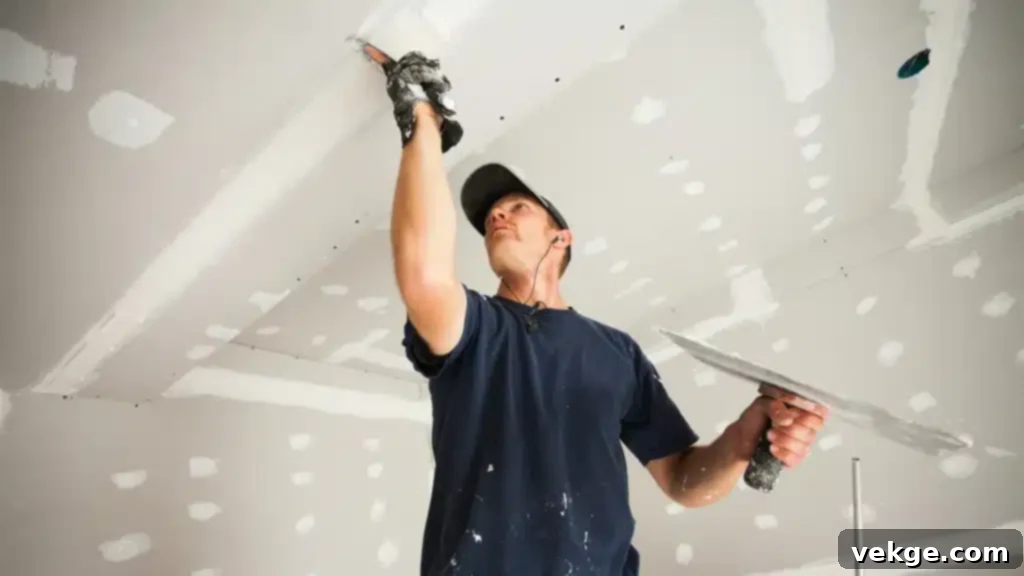
The “Mud and Tape” ceiling, often referred to as a smooth drywall finish, is one of the most prominent and trendy options in modern home design. While it might not be a “texture” in the conventional sense of having a raised pattern, it represents a highly refined surface treatment that contrasts sharply with textured alternatives. The process involves meticulously taping all joints where drywall sheets meet and then applying multiple layers of drywall compound (mud) to these taped areas and the screw indentations.
The goal is to achieve an absolutely seamless and perfectly flat surface. This process demands considerable skill, patience, and meticulous sanding between coats to eliminate any visible seams, bumps, or imperfections. While it might initially appear to be a simpler finish, achieving a truly flawless smooth ceiling can be more labor-intensive and, consequently, slightly more costly than applying certain textures, especially if professional craftsmanship is required.
Despite the effort, the result is a clean, crisp, and timeless aesthetic that makes a room feel more spacious and reflects light beautifully, contributing to a brighter environment. A smooth ceiling provides a versatile backdrop for any decor style, from minimalist to contemporary or even traditional, without competing with other design elements. If not for the entire home, this option is highly recommended for bedrooms and living rooms where its clean lines can amplify the overall look of your space and create a serene, uncluttered atmosphere. It’s the ultimate choice for those who appreciate understated elegance and a refined finish.
6. Plain Ceiling Texture (Smooth Ceiling)

While intricate patterns and textures offer unique appeal, the timeless elegance of a plain, smooth ceiling remains a top choice for many homeowners. The reason for its enduring popularity is multifaceted: smooth ceilings provide a consistent, polished, and understated appearance that seamlessly integrates with any interior design style. They offer a clean slate that allows other elements in the room – such as artwork, furniture, or feature walls – to take center stage without visual competition.
One of the most compelling advantages of a plain ceiling is its cost-effectiveness. It is generally less expensive to achieve a smooth finish compared to applying complex textures, as it requires fewer specialized materials and often less specialized labor (though achieving a *perfectly* smooth finish still requires skill). Furthermore, smooth ceilings are much easier to clean and repaint than textured ones, which can accumulate dust and be challenging to maintain. Removing a smooth ceiling for repairs or changes is also far simpler than dealing with heavily textured surfaces like popcorn ceilings.
From a design perspective, smooth ceilings make rooms feel larger, airier, and brighter by reflecting light more uniformly across the space. This characteristic is particularly beneficial in smaller rooms or those with limited natural light. Its simplicity is its strength, making it the most versatile option that complements any color scheme or decor style effortlessly. If your priorities are simplicity, spaciousness, ease of maintenance, and budget-friendliness, then a pristine white or subtly colored smooth ceiling is undoubtedly the ideal choice for your home.
Wrapping it Up: Choosing Your Perfect Ceiling Aesthetic
Ceiling designs and textures are far from mere afterthoughts in home decor; they are pivotal elements that can dramatically enhance the overall look and feel of your living spaces. From the intricate artistry of Sand’s Swirl and the luxurious appeal of floral patterns to the organic charm of slap brush and the sleek elegance of a smooth finish, each style offers a unique opportunity to express your personal taste and elevate your home’s aesthetics.
Making the right choice involves thoughtful consideration of several factors: the architectural style of your home, the size and natural light of the room, your existing decor, your maintenance preferences, and, of course, your budget. Do you desire a rustic warmth, a contemporary sleekness, or a touch of classic grandeur? The ceiling texture you select should harmoniously align with these aspects, creating a cohesive and inviting environment.
Ultimately, the perfect ceiling selection is one that not only enhances the visual appeal of your room but also resonates with your personal style, contributing to a space that feels uniquely yours. We hope this comprehensive guide has illuminated the vast possibilities of ceiling design and provided you with valuable insights to embark on your next home improvement project. Explore these options, visualize them in your space, and don’t hesitate to seek professional advice to bring your ceiling dreams to life.
We’d love to hear your thoughts and ideas! Share your experiences or additional insights on selecting different ceiling textures in the comments below.
